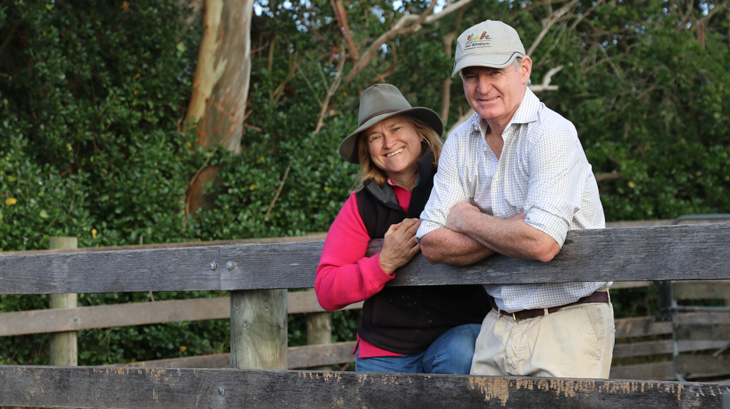Managing invasive species a key factor for biodiversity

Victorian beef producer and Australian Beef Sustainability Framework (ABSF) Sustainability Steering Group (SSG) member Jenny O’Sullivan (pictured, left) agrees wholeheartedly with one of the key targets set at last month’s COP15 global summit on biodiversity: reducing the effects of invasive species.
The target, set in the Kunming-Montreal pact, calls on countries to control and eradicate invasive species, particularly from high-value environmental sites, and to prevent the introduction and establishment of high risk ‘priority’ pests. It’s also a goal of the ABSF.
In 1991 when Jenny and her husband Paul returned to run her family’s 664ha holding, Malabar Farm at Tarwin Lower in Gippsland, they set about fencing off waterways, wetlands and stands of remnant bush, some of which contained 300-year-old grass trees.
Setting aside 93ha and providing shade and shelter in every paddock significantly increased productivity but created extra work in managing weeds and invasive species.
“As you get more bush on the farm it becomes a bigger job and it’s really important to manage this, because if you don’t, things go backwards,” Jenny said.
“One of our challenges is controlling weeds like blackberries and thistles in areas where we’ve excluded stock. Invasive animals are also an issue. We’ve seen a significant increase in deer numbers in the last few years and they’re doing enormous damage to trees and mid-storey habitat like bushes and shrubs that are critical shelter for birds.”
Ad hoc control of deer by landholders hasn’t been enough to manage or reduce numbers so they’ve helped to instigate a community deer control program for Cape Liptrap and Tarwin Lower, linking up with professional and commercial harvesters to manage and reduce the population.
The O’Sullivans run 420 cows and 2,000 ewes and at any one time may have up to 1,000 cattle and 3,000 lambs on Malabar Farm, named after the book by American writer and sustainable agriculture proponent, Louis Bromfield.
They can hear the ocean from their farm, which lies five kilometres inland from Bass Strait and a short drive from the Ramsar-listed wetlands of Corner Inlet, home to many migratory bird species.
“We don’t have any permanent waterways but we have ephemeral streams where we get migratory swans and birds coming through and breeding in winter and spring. Some of these birds may have flown right around the world so we don’t want them to come here and find the deer have wiped out their habitat,” Jenny said.
“We’re monitoring four spots on the farm every season for 20 minutes, to record the number and diversity of birds and to track over time which birds are visitors as well as those that are living and thriving here.”
Through Landcare, they also monitor the local dung beetle population.
“Dung beetles are very important to what we do because they bury manure deep into the ground to help with nutrient storage and recycling. There are so many aspects to biodiversity, having to manage water, land and vegetation in a changing climate and consider the impact of that on nature. Ideally it’s a positive one,” Jenny said.
While the coastal region has attracted a large contingent of sea and tree changers moving to Gippsland from the city, Jenny says this has delivered a much richer and more diverse community with great creativity and culture – in effect, more biodiversity of people.
The family recently featured in the sustainability campaign of fashion retailer Country Road Australia, showcasing their innovation and commitment to biodiversity through Landcare.
While there is currently no requirement to report biodiversity actions, Jenny believes there may be opportunities in the future to earn credits and support for farmers in the same way as the current carbon accounting schemes.
Meat & Livestock Australia (MLA) and Queensland University of Technology have begun research into accounting for biodiversity as a co-benefit associated with grazing management, and MLA is leading the creation of an online tool for grassfed beef producers to verify their biodiversity credentials on-farm.
“There is a misconception that farmers are damaging the land, but we’re actually working really hard to improve it. An enormous amount of money has been invested by state and federal government organisations, Landcare and local farm groups like catchment management authorities, but people don’t know that’s going on,” Jenny said.
“The work on carbon is a great example of what can be done. What we’ve achieved as we work towards being carbon neutral is amazing, so we need to keep communicating and educating people about our work.”
ABARES data shows that 7.6 million hectares of cattle country in Australia has been set aside for conservation purposes, and its Producer Survey revealed that the percentage of cattle-producing land actively managed for biodiversity outcomes was 43% in 2021.
Jenny O’Sullivan considers the commitment to biodiversity on Malabar Farm to be an integral part of farming, and says it results in a better quality of life for both people and animals.
“We’re not unique – there are many farmers throughout Australia doing this, and all of us like to learn and share ideas with new farmers coming in. Most people who are farming love the land and want to leave it a better place when they go,” she said.